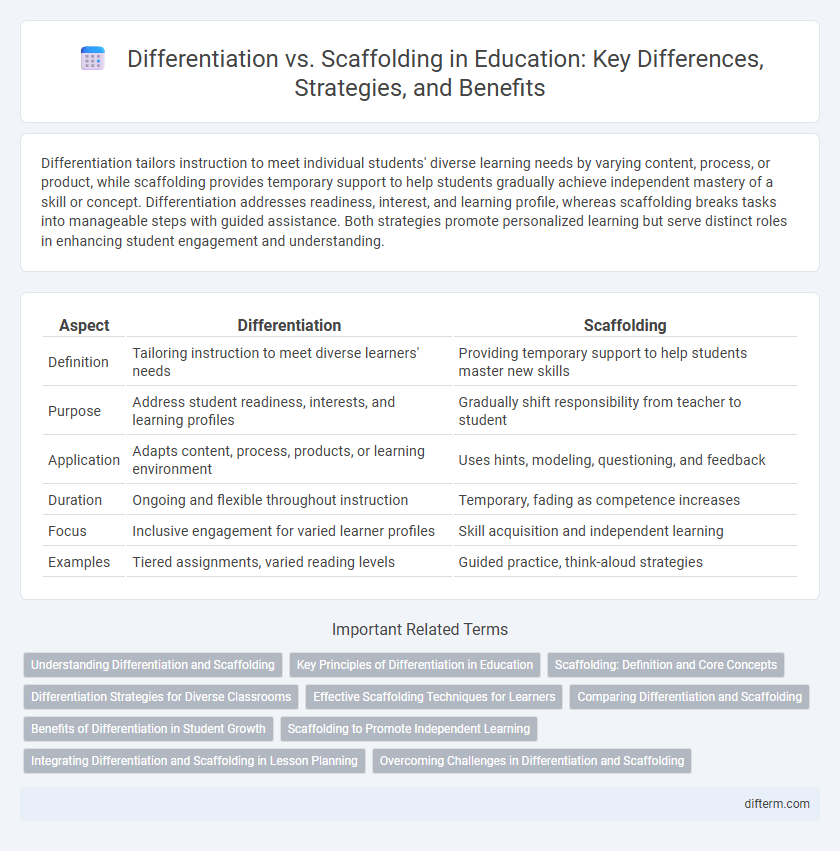Differentiation tailors instruction to meet individual students' diverse learning needs by varying content, process, or product, while scaffolding provides temporary support to help students gradually achieve independent mastery of a skill or concept. Differentiation addresses readiness, interest, and learning profile, whereas scaffolding breaks tasks into manageable steps with guided assistance. Both strategies promote personalized learning but serve distinct roles in enhancing student engagement and understanding.
Table of Comparison
| Aspect | Differentiation | Scaffolding |
|---|---|---|
| Definition | Tailoring instruction to meet diverse learners' needs | Providing temporary support to help students master new skills |
| Purpose | Address student readiness, interests, and learning profiles | Gradually shift responsibility from teacher to student |
| Application | Adapts content, process, products, or learning environment | Uses hints, modeling, questioning, and feedback |
| Duration | Ongoing and flexible throughout instruction | Temporary, fading as competence increases |
| Focus | Inclusive engagement for varied learner profiles | Skill acquisition and independent learning |
| Examples | Tiered assignments, varied reading levels | Guided practice, think-aloud strategies |
Understanding Differentiation and Scaffolding
Differentiation involves tailoring instruction to meet individual learners' needs by varying content, process, and product based on students' readiness, interests, and learning profiles. Scaffolding provides temporary support structures, such as guided questions or modeling, to help students progress toward independent mastery of specific skills or concepts. Both strategies aim to enhance student achievement by addressing diverse learning challenges within the classroom environment.
Key Principles of Differentiation in Education
Key principles of differentiation in education include tailoring instruction to meet diverse learner needs by varying content, process, and product based on students' readiness, interests, and learning profiles. Effective differentiation involves ongoing assessment and flexible grouping to optimize engagement and success for every student. Unlike scaffolding, which provides temporary support, differentiation focuses on sustained adjustments that empower independent learning.
Scaffolding: Definition and Core Concepts
Scaffolding in education is a teaching strategy that provides temporary support to students to enhance learning and mastery of new concepts. It involves breaking tasks into manageable parts, offering guidance, and gradually removing assistance as learners become more independent. Core concepts include modeling, prompting, questioning, and providing feedback tailored to individual student needs to foster skill development and confidence.
Differentiation Strategies for Diverse Classrooms
Differentiation strategies in diverse classrooms involve tailoring instruction to meet varied student needs by modifying content, process, and product based on students' readiness levels, interests, and learning profiles. Effective differentiation includes flexible grouping, tiered assignments, and ongoing assessment to provide appropriate challenges and support for every learner. These approaches promote equity by ensuring all students have access to meaningful, personalized learning experiences that enhance engagement and academic success.
Effective Scaffolding Techniques for Learners
Effective scaffolding techniques for learners include modeling tasks, providing clear, step-by-step instructions, and gradually transferring responsibility to the student. Utilizing tools such as graphic organizers, guided questioning, and timed supports enhances comprehension and skill acquisition. Scaffolding adapts to individual learning needs, promoting independence while maintaining optimal challenge levels.
Comparing Differentiation and Scaffolding
Differentiation involves tailoring instruction to meet diverse student needs by varying content, process, and products based on readiness, interest, or learning profile, while scaffolding provides temporary support structures to help students achieve a higher level of understanding or skill. Differentiation emphasizes customization across the entire learning experience, whereas scaffolding concentrates on step-by-step guidance within specific tasks to gradually transfer responsibility to the learner. Both strategies enhance personalized learning but serve distinct roles: differentiation addresses broader curriculum adaptation, and scaffolding focuses on moment-to-moment instructional support.
Benefits of Differentiation in Student Growth
Differentiation in education promotes personalized learning by addressing individual students' strengths, needs, and interests, which enhances engagement and motivation. Tailoring instruction through varied content, process, and product allows students to master concepts at their own pace, resulting in improved academic achievement and confidence. Research shows that differentiated classrooms foster critical thinking, creativity, and self-regulation, contributing to sustained student growth and success.
Scaffolding to Promote Independent Learning
Scaffolding in education provides structured support that gradually diminishes as students develop mastery, enabling them to engage in independent learning confidently. Unlike differentiation, which adjusts content and tasks for diverse learners, scaffolding focuses on guiding students through challenging concepts by offering temporary aids such as prompts, models, and feedback. Research indicates that effective scaffolding fosters metacognitive skills and self-regulation, critical for students to become autonomous learners capable of tackling new problems independently.
Integrating Differentiation and Scaffolding in Lesson Planning
Integrating differentiation and scaffolding in lesson planning enhances personalized learning by tailoring instruction to diverse student needs while providing structured support to build skills progressively. Effective lesson plans incorporate differentiated activities that address varying readiness levels, interests, and learning profiles alongside scaffolding strategies such as modeling, guided practice, and gradual release of responsibility. This combined approach fosters deeper understanding and independent mastery by aligning instructional methods with both individual capabilities and cognitive development stages.
Overcoming Challenges in Differentiation and Scaffolding
Overcoming challenges in differentiation requires teachers to accurately assess individual student readiness, interests, and learning profiles to tailor instruction effectively, avoiding one-size-fits-all approaches. Scaffolding demands flexible support structures that gradually release responsibility to students, ensuring mastery while preventing dependency or frustration. Balancing these strategies enhances personalized learning, promotes student autonomy, and addresses diverse cognitive and emotional needs in the classroom.
differentiation vs scaffolding Infographic

 difterm.com
difterm.com